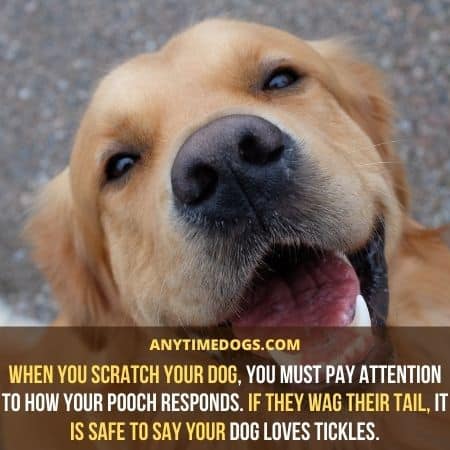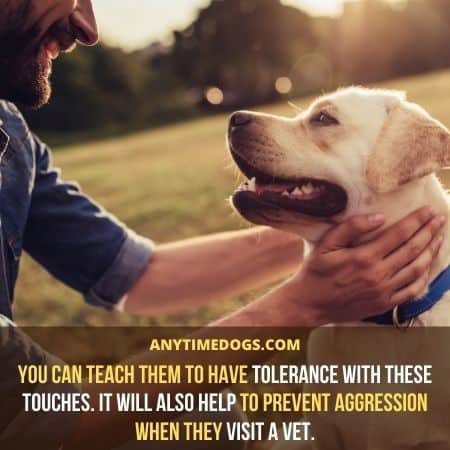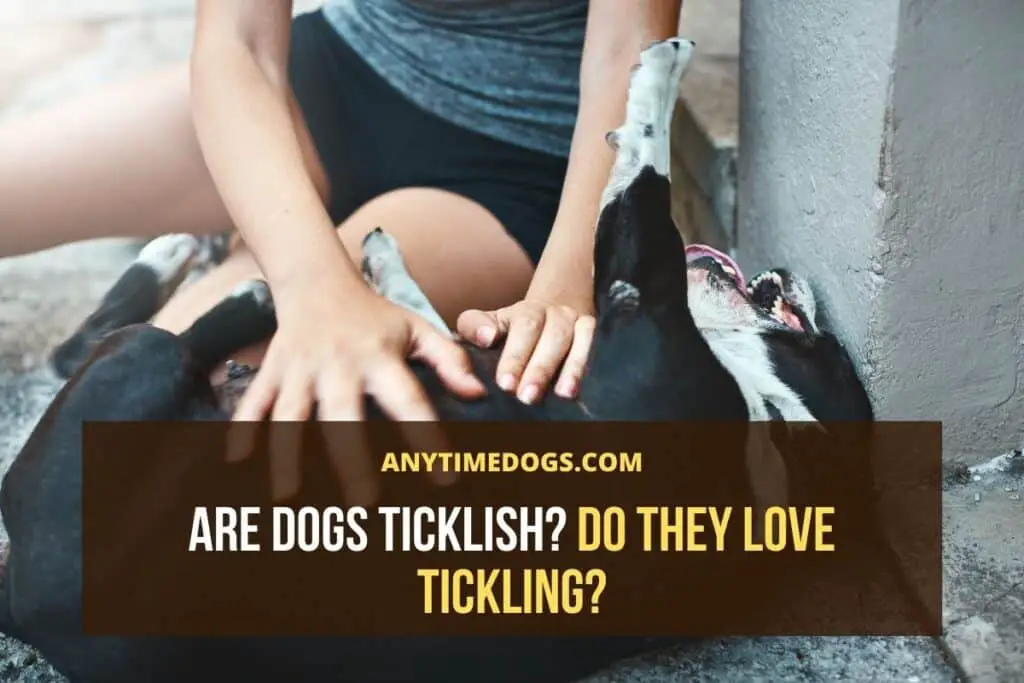There is no surprise that humans are ticklish, but have you ever wondered are dogs ticklish too?
In short YES Dogs are ticklish too. It depends on how you touch your canine friend. Usually, a tickle is an unconscious response to touch. In humans, there a few vulnerable areas that are prone to tickles.
These areas result in uncontrollable laughter. Most pet owners have found the right tickling spot of their furry friends, which they enjoy.
If you think about it, tickling is quite weird. Touching few areas of the body results in involuntary giggles and wiggles. The best part is, it puts you in a great mood.
Does your furry friend feel the same when you tickle them?
In this article, we will find out the answer!
How To Know If Your Dog Is Ticklish?
According to studies, dogs have the same sensations and nerve endings in their fur and skin as humans. It means dogs are ticklish.
Humans respond to tickling by using emotional reactions like laughing and enjoying. The same is with dogs, as the response depends on how we tickle them. But, some dogs are more ticklish than others.
There is a wide range of responses that dogs exhibit when tickled. It includes jerking, wiggling, or jolting the legs in the rhythm of tickle.
In dog terms, it is a “scratch reflex.” Because it is an uncontrolled response to this type of touch.
Some dogs pass a smile that looks like a wrinkled face and bare teeth. While others flick their ears, pull their feet away, or shimmy their back.
1) Do Dogs Love Tickles?
Most dogs jump on you because they want their masters to scratch their bellies or tickle them.
It means that dogs like having tickles.

When you scratch your dog, you must pay attention to how your pooch responds. If they wag their tail, smile with their tongue out, and rolls on their back, it is safe to say your dog loves tickles.
These four-legged creatures are the most loving and caring pets a person can have. The amount of love and loyalty they give to us, we should return it too.
Apart from food and health care, pups need physical affection too. Some dogs love scratching and petting, while others don’t.
If your dog recoils when you tickle them, they might find tickling uncomfortable. Flinching away from the touch and raised haunches are also some of the signs.
If your puppy feels pain when you scratch them, do contact a vet. It occurs due to dry skin, fleas, or sore joints.
While sore joints are common in old dogs, you must still talk to a vet and cure this problem.
2) What Are The Dog’s Most Ticklish Areas?
Are dogs ticklish? Yes, they are. Like humans’ dogs have certain areas too, which are ticklish. Their belly is the go-to spot for tickling. Other areas include:
- Chest
- Between their front legs
- On the back legs near the tail
- Ears
- Paws
It would help if you kept scratching until you have found the right spot. When they grin or thump their foot, that’s the perfect spot.

This “scratch reflex” is an involuntary response. When you scratch your pup, it activates the nerves under the skin. These nerves connect to the spinal cord & send messages to the muscles to come into action.
Vets also use this method to determine any neurological issues. If there is no movement after scratching, there is some neurological trauma. It can also be a case of nerve damage.
3) Dogs And Their Leg Kicks While Tickling:
We are sure that you have found the perfect tickling spot in your furry friend!
But what’s up with their kicking legs when you start tickling them?
As soon as you hit the “sweet spot,” kicking their legs is an uncontrollable reflex to your scratching.

When you rub their belly, the doggo feels a tickly sensation. It sends a message to their brain, and they start moving their legs in a rhythmic movement.
Your touch activates the neurological pathway in specific areas of your pup. Naturally, the side of the body you scratch coincides with the side of the leg that moves.
Some researchers say the tickles produce an itch-like sensation. The dog thinks the spot is itchy, so they scratch the area. It is possible that they, something, is crawling beneath their skin, like a flea.
4) The Science Behind Dogs Being Ticklish:
“Knismesis” and “Gargalesis” are two terms that two psychologists invented. These words classify two types of tickling.
Knismesis is a light, feather-like tickling. This touch may not induce laughter but can create an itch-like sensation.
It is common in most animals, especially dogs. This sensation is due to a bug crawling on their skin like a flea.
On the other hand, gargalesis is a heavier laughter-inducing tickling. When a person applies repeated high pressure on a sensitive area, the dogs feel a sense of joy.
5) History Behind Dogs Being Ticklish:
In 1897, G. Stanley Hall and Arthur Allin coined the terms “knismesis” and “gargalesis”. In the American Journal of Psychology.
After these terms, many responses to the tickling were present in various animals. These species included rats, primates, and dogs.
These studies link with gargalesis because scientists associate tickling with “social joy.” The playful tickling behavior is not only seen in dogs. Chimpanzees, gorillas, and bonobos also depict this behavior.
However, there aren’t much researches that show dogs experiencing gargalesis. Some owners reported that their pooch leans against her and want to get tickled. Their sensitive spot was the armpits.
Another owner reported that their pup loves when they scratch the neck. Moreover, they extend their legs out.
These scenarios helped the researchers to reach a concluding point. These responses indicate that dogs can have multiple sensitive areas. And they experience a pleasant reaction to the touch.
Psychologists interpreted these involuntary responses as dogs being ticklish.
6) Do Dogs Laugh After Tickling?
According to recent studies, dogs can laugh too when you tickle them. As it creates a sense of “social joy,” they emit sounds of happiness.

Dogs are somewhat similar to humans, just like they have organs like tonsils similar to humans or lustrous eyelashes that perform the same functions as it does in humans. Likewise, dogs also laugh after tickling but not exactly like us.
For humans erupt into a fit of laughter after tickling. But, this doesn’t occur in dogs in the first place. Dogs don’t laugh the same as humans. But, they do exhibit behaviors considered as laughing.
Dogs show different types of breath or panting when scratched.
The breathing intensity may vary with the tickling pace. But you shouldn’t expect a genuine giggle.
7) How To Tickle A Dog?
Tickling is relatively easy for fluffy friends. Wiggling your fingers on the ticklish spot is all you need to do!
But, keep their reactions in your mind. If they don’t like it, you should stop immediately. Most of the time, dogs who love tickles aren’t in the mood.
The best time to tickle them is when they sit on your lap.
As humans, you only want the closest people to tickle you. The same is with dogs. They only prefer touching by humans they trust.
In short, they have fun in an environment where they feel safe. If you are not familiar with a dog, don’t try to tickle them as they become aggressive.
8) How To Train Dogs To Become Ticklish?
You can’t train your dogs to feel the tickles.
It is simply an involuntary response to touch. Some dogs feel more than others.
But, you can train your canine by increasing their comfort level. It also helps in accepting specific touches.
Some dogs don’t like contacts on their belly or paws.

You can teach them to have tolerance with these touches. It will also help to prevent aggression when they visit a vet, groomers, or social settings.
It essential to ensure that your dog doesn’t have any health problems related to touching their fur. Once you know the underlying cause of being resistant to touch, it is easy to touch-train.
Slowly move your hand on their sensitive areas and reward your dog with praises and treats. If this technique works, keep touching the areas with lots of praise.
You must pay close attention to your pet’s body language. If they are calm, then you are good to go.
Final Words:
All in all, we know that dogs feel tickles in their sensitive areas. But, you should watch for signs if your pup has overly sensitive skin.
Don’t harshly rub your pet’s skin and gently scratch them as you don’t want them to get hurt.
Remember, comfort is the key to a happy relationship with your doggo. Hence, it is necessary to gain your pet’s consent first before tickling them.

